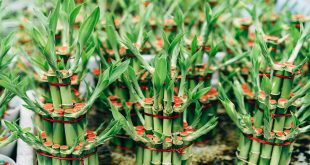Yes, lucky bamboo can be cut and replanted to propagate new plants. Lucky bamboo is a popular indoor plant known for its resilience and low maintenance requirements.
Many plant enthusiasts enjoy the process of cutting and replanting lucky bamboo to expand their collection or share with friends and family. In this article, we will discuss the steps to successfully cut and replant lucky bamboo, as well as some important tips to ensure the health and vitality of the new plants.
So, if you’re interested in growing your own lucky bamboo or simply want to learn more about this fascinating plant, keep reading.
Understanding Lucky Bamboo
Lucky bamboo, with its graceful and vibrant appearance, is a popular plant that is believed to bring good luck and positive energy. If you’re a plant lover, you may have wondered whether you can cut and replant lucky bamboo to create more of these auspicious plants.
In this section, we’ll delve into the fascinating world of lucky bamboo, exploring its origins, cultural significance, and growth patterns.
The Origins And History Of Lucky Bamboo
- Lucky bamboo, scientifically known as dracaena sanderiana, is native to the tropical rainforests of west africa.
- It gained popularity in east asia, particularly in china, where it is considered a symbol of luck and prosperity.
- Historically, lucky bamboo was regarded as a sacred plant and was often used in feng shui practices to attract positive chi.
The Significance Of Lucky Bamboo In Different Cultures
- In chinese culture, lucky bamboo is believed to bring good fortune, wealth, and protection from negative forces. It is often given as gifts during weddings, birthdays, and other special occasions.
- In feng shui, lucky bamboo is often placed in homes and offices to enhance positive energy and promote harmony and balance.
- In indian culture, lucky bamboo is associated with lord ganesha, the god of wisdom and prosperity, and is often used in religious ceremonies and rituals.
The Characteristics And Growth Patterns Of Lucky Bamboo
- Lucky bamboo is not actually bamboo, but a member of the dracaena family, which includes over 40 different species of plants.
- It is known for its long, slender stems and glossy green leaves, which can vary in shape and size depending on the variety.
- Lucky bamboo is easy to care for and can grow in water or soil. It requires indirect light and should be watered regularly to keep the roots moist.
Whether you’re looking to expand your lucky bamboo collection or simply curious about this interesting plant, understanding its origins, cultural significance, and growth patterns can help you appreciate its beauty even more. So, let’s dive deeper into the world of lucky bamboo and discover the secrets behind its allure.
Can You Cut Lucky Bamboo?
Lucky bamboo, with its graceful appearance and easy-care nature, has become a popular choice for both indoor and outdoor decor. As a plant lover, you may be wondering whether it’s possible to cut and replant lucky bamboo. In this section, we will delve into the intriguing world of lucky bamboo propagation, focusing on the question: can you cut lucky bamboo?
Factors To Consider Before Cutting
Before you grab your pruning shears and start cutting away, it’s important to take a few factors into consideration. Here are some key points to keep in mind:
- Health of the plant: Ensure that your lucky bamboo plant is healthy and robust before attempting to cut it. Plants that are weak or struggling may not survive the cutting process.
- Size of the plant: Lucky bamboo can range in size from small potted plants to towering stalks. Consider the overall size and structure of your plant before deciding to cut.
- Purpose of cutting: Determine why you want to cut your lucky bamboo. Are you looking to propagate new plants or simply reshape and rejuvenate the current plant? This will influence the technique you use.
The Appropriate Tools And Techniques For Cutting
To successfully cut lucky bamboo, you’ll need the right tools and techniques. Here are some important points to keep in mind:
- Tools: Use clean and sharp pruning shears or a sharp knife to make precise cuts. Dull blades can cause damage to the plant.
- Choosing the right section to cut: Look for healthy, vibrant sections of the stalk that have at least two nodes, as these are the areas where new roots will form.
- Cutting technique: Make a clean, diagonal cut just below a node, ensuring that each cutting has at least one or two nodes intact. This will promote new growth and root development.
- Water propagation: Once you have your cuttings, place them in a container with water, making sure the nodes are submerged. Change the water regularly to prevent bacterial growth.
Remember to handle your lucky bamboo with care throughout the cutting process to avoid any unnecessary damage. With the proper tools, techniques, and a dash of luck, you can indeed cut and replant lucky bamboo to propagate new plants or revitalize your existing ones.
Replanting Lucky Bamboo
Lucky bamboo is a popular indoor plant known for its ability to bring good luck and positive energy to any space. But what happens when your lucky bamboo starts to outgrow its pot? Can you simply cut and replant it?
The answer is yes! In this section, we will guide you through the process of replanting lucky bamboo, ensuring a smooth transition for your beloved plant. So, let’s get started!
Preparing The New Pot Or Container
Before you begin the replanting process, it is essential to have a new pot or container ready. Here are some key points to consider when preparing the new home for your lucky bamboo:
- Choose a pot or container that is slightly larger than the current one to allow room for growth.
- Ensure that the new pot has drainage holes to avoid waterlogging and promote healthy root growth.
- Thoroughly clean the new pot before use to eliminate any potential diseases or pests.
Selecting The Right Soil And Water Conditions
When it comes to the soil and water conditions for your lucky bamboo, there are a few important factors to keep in mind:
- Use a well-draining, nutrient-rich potting soil specifically designed for indoor plants.
- Avoid using soils that are too compact or heavy, as they can lead to waterlogged roots.
- Keep the soil consistently moist but not overly saturated to prevent root rot.
- Consider using filtered or bottled water, as tap water may contain chemicals that can harm your lucky bamboo.
Transplanting The Cut Lucky Bamboo
Now that you have prepared the new pot and selected the ideal soil and water conditions, it’s time to transplant your cut lucky bamboo. Here’s a step-by-step guide to help you through the process:
- Begin by carefully removing the lucky bamboo from its current pot, gently loosening the roots if necessary.
- Examine the stem and select a healthy section to cut. Ensure that each cutting has at least one node, as this is where new growth will emerge.
- Dip the cut end of the bamboo in rooting hormone powder to encourage faster root development.
- Place the cutting into the new pot, ensuring that the node is submerged in the soil and the stem is securely upright.
- Gently press the soil around the stem to provide stability for the bamboo.
- Water the plant thoroughly but avoid overwatering, as too much moisture can lead to root rot.
- Find a suitable location for your replanted lucky bamboo, preferably an area with indirect sunlight and consistent temperatures.
Follow these steps, and you’ll successfully replant your lucky bamboo, giving it room to flourish and bring good fortune to your space. Remember to monitor its growth, provide regular care, and enjoy the beauty of this resilient and auspicious plant.
Care Tips For Replanted Lucky Bamboo
Replanting lucky bamboo can be a rewarding experience, allowing you to create new green companions for your home or office. However, ensuring the well-being of the lucky bamboo after replanting is important to maintain its vitality and beauty. By following these care tips, you can help your replanted lucky bamboo thrive:
Providing Adequate Sunlight And Water
- Sunlight: Lucky bamboo requires indirect sunlight to grow properly. Place your replanted lucky bamboo in a location where it can receive bright but filtered light, such as near a window with a sheer curtain. Avoid exposing it to direct sunlight, as it can scorch the leaves.
- Water: Lucky bamboo is a water-loving plant, so it’s crucial to keep it hydrated. Ensure the replanted lucky bamboo’s container has enough water to cover the roots at all times. Use filtered or distilled water to prevent the buildup of harmful minerals. Check the water level regularly and add more as needed to maintain consistent moisture.
Maintaining The Right Temperature And Humidity
- Temperature: Lucky bamboo thrives in temperatures ranging from 65 to 90 degrees fahrenheit (18 to 32 degrees celsius). Avoid placing it in areas with extreme temperature fluctuations or near heating or cooling vents.
- Humidity: Lucky bamboo enjoys humid conditions, so misting the leaves with water occasionally can help increase the humidity around the plant. You can also place the replanted lucky bamboo on a tray filled with water and pebbles to create a humid microclimate.
Fertilizing And Pruning The Replanted Lucky Bamboo
- Fertilizing: Lucky bamboo benefits from periodic fertilizing to maintain its health. Use a liquid or granular houseplant fertilizer specifically formulated for lucky bamboo. Follow the instructions on the fertilizer packaging for the appropriate dosage and frequency.
- Pruning: As the replanted lucky bamboo grows, it may develop yellowing or dying leaves. Prune these damaged or yellowed leaves using clean pruning shears to encourage new healthy growth. Additionally, if the lucky bamboo becomes too tall or top-heavy, you can trim the stalks to regulate its height.
By paying attention to these care tips, you can provide a suitable environment for your replanted lucky bamboo to flourish. Remember, each plant may have unique needs, so observe your plant closely and make adjustments as required to ensure its well-being.
With proper care, your replanted lucky bamboo can bring joy and tranquility to your space.
Common Issues And Troubleshooting
Lucky bamboo is a popular houseplant known for its striking appearance and symbolic significance. It’s often used to bring good luck and prosperity into homes and offices. If you have a lucky bamboo plant that has grown too tall or is experiencing issues, you might be wondering if you can cut and replant it.
We’ll discuss common issues and troubleshooting techniques for lucky bamboo, including signs of overwatering or underwatering, pest control, and dealing with yellowing or wilting leaves.
Signs Of Overwatering Or Underwatering:
- Yellowing or browning leaves: Overwatering can cause the leaves to turn yellow or brown. Underwatering, on the other hand, can lead to dry, crispy leaves.
- Root rot: Overwatering can lead to root rot, which is a condition where the roots become waterlogged and start to decay. This can cause the plant to wilt and the leaves to droop.
- Mushy stems: If the stems of your lucky bamboo plant feel mushy or soft, it could be a sign of overwatering. This can be caused by excessive moisture, which can lead to root rot.
Pest Control For Lucky Bamboo:
- Spider mites: These tiny pests can infest lucky bamboo plants and cause damage to the leaves. Look out for fine webbing on the plant and tiny specks on the leaves, indicating the presence of spider mites. To control them, gently wipe the leaves with a damp cloth and use insecticidal soap if necessary.
- Mealybugs: Mealybugs are white, cottony pests that can also infest lucky bamboo plants. They suck the sap out of the plant, causing it to weaken and decline. To eliminate mealybugs, dab them with a cotton swab dipped in rubbing alcohol.
Dealing With Yellowing Or Wilting Leaves:
- Too much direct sunlight: Lucky bamboo prefers bright, indirect light. If the plant is exposed to too much direct sunlight, it can cause the leaves to turn yellow or wilt. Move the plant to a spot with less direct sunlight to avoid this issue.
- Inadequate watering: Underwatering can cause the leaves to yellow or wilt. Make sure to keep the soil consistently moist but not soggy. Water the plant when the top inch of soil feels dry to the touch.
- Cold temperature: Lucky bamboo is sensitive to cold temperatures. If the plant is exposed to cold drafts or temperatures below 55°f (13°c), it can lead to yellowing or wilting leaves. Keep the plant away from cold drafts and maintain a temperature above 55°f (13°c).
Remember, lucky bamboo can be cut and replanted, but it’s essential to address any underlying issues before doing so. By identifying signs of overwatering or underwatering, implementing proper pest control measures, and addressing yellowing or wilting leaves, you can help your lucky bamboo thrive and bring good luck to your space.
Caring For Lucky Bamboo In The Long Run
Lucky bamboo is a popular houseplant known for its sleek and elegant appearance. Many people wonder if they can cut and replant lucky bamboo to create new plants or simply maintain its health. We will explore the topic of cutting and replanting lucky bamboo, focusing on how to care for the plant in the long run.
Proper maintenance and grooming, propagating through division, and creating an ideal environment are key factors to ensure the continuous growth and prosperity of your lucky bamboo.
Regular Maintenance And Grooming
Maintaining a healthy and attractive lucky bamboo plant requires some regular care and grooming. Here are a few key points to remember:
- Remove any yellow or damaged leaves promptly to maintain the plant’s overall health and appearance.
- Keep an eye out for signs of overgrowth, such as crowded foliage or tangled roots. If needed, trim the excess growth to preserve the plant’s shape and balance.
- Clean the leaves and stems occasionally using a soft cloth or sponge to remove dust and maintain their vibrant green color.
Propagating Lucky Bamboo Through Division
If you wish to expand your collection of lucky bamboo or rejuvenate an aging plant, division is a reliable method of propagating new plants. Consider the following steps:
- Carefully remove the bamboo from its container and separate the roots into individual sections, ensuring that each section has at least two or three stems.
- Prepare new containers filled with fresh water or well-draining soil. Place each divided section into its own container, making sure the roots are fully submerged or covered with soil.
- Provide the newly propagated plants with appropriate lighting and water them regularly to promote healthy growth.
Creating A Favorable Environment For Lucky Bamboo Growth
To ensure the long-term health and growth of your lucky bamboo, it is crucial to create an environment that meets its specific needs. Here are a few important factors to consider:
- Lighting: Lucky bamboo thrives in bright, indirect sunlight. Avoid exposing it to direct sunlight, as it can scorch the leaves. Place the plant near a window or use artificial lights to provide adequate lighting.
- Watering: Keep the roots of lucky bamboo constantly moist but avoid waterlogging. Use distilled water, filtered water, or tap water that has been left out for at least 24 hours to allow chlorine to dissipate.
- Temperature and humidity: Lucky bamboo prefers temperatures between 65-90°f (18-32°c) and moderate humidity levels. Avoid placing it in drafty areas or near heating or cooling vents.
- Fertilization: Use a diluted balanced liquid fertilizer once a month during spring and summer to provide essential nutrients for healthy growth.
- Container and soil: Select a container that is large enough to accommodate the roots and provides stability. Choose well-draining soil or use water for hydroponic growth.
By adhering to these guidelines for regular maintenance and grooming, propagating through division, and creating a favorable environment, you can ensure the long-term health and prosperity of your lucky bamboo. With proper care, your lucky bamboo will continue to bring beauty and good fortune to your home or office space for years to come.
Frequently Asked Questions On Can You Cut And Replant Lucky Bamboo?
Can Lucky Bamboo Be Cut And Replanted?
Yes, lucky bamboo can be cut and replanted. It’s best to make clean cuts just above a node, and you can use the cuttings to start new plants in water or soil. Remember to provide proper care, including regular watering and indirect light, for successful growth.
How Do You Propagate Lucky Bamboo?
Lucky bamboo can be propagated by cutting a healthy stalk just above a node and placing it in water or soil. Keep the cutting in a well-lit area with indirect sunlight, and change the water regularly if using the water method.
Rooting hormone can also be used to encourage quicker rooting.
What Is The Best Time To Cut And Replant Lucky Bamboo?
The best time to cut and replant lucky bamboo is during its active growth phase, which is typically in spring or early summer. This allows the plant to heal and establish new roots more effectively than during its dormant phase.
Be sure to avoid cutting during extreme temperatures or adverse weather conditions.
Can I Cut Lucky Bamboo Leaves?
Yes, you can cut lucky bamboo leaves if they appear damaged, brown, or yellow. Use clean scissors or pruning shears to make clean cuts near the base of the leaf. Removing unhealthy foliage can help promote overall plant health and aesthetics.
Avoid cutting too many leaves at once to maintain a healthy balance.
How Often Should I Water My Newly Replanted Lucky Bamboo?
After replanting lucky bamboo, it’s essential to water it adequately. Keep the soil or water slightly moist, but avoid overwatering, as it can lead to root rot. Check the moisture level every few days and adjust watering frequency accordingly, taking into account the environmental conditions of your specific location.
Conclusion
Lucky bamboo can indeed be cut and replanted with great success. This versatile plant offers so many possibilities for propagation and growth, making it a favorite among plant enthusiasts. By following the proper steps, which include sterilizing tools, selecting healthy sections, and applying rooting hormone, you can ensure the best chance of success when cutting and replanting lucky bamboo.
Remember to provide proper care and maintenance to the newly planted cuttings, such as appropriate lighting, temperature, and water requirements. With patience and dedication, you can watch as your cuttings take root and grow into thriving new plants. Whether you are a seasoned gardener or a beginner in the world of plants, experimenting with lucky bamboo can be a rewarding experience.
 GardenXpert Garden Advice Blog
GardenXpert Garden Advice Blog





